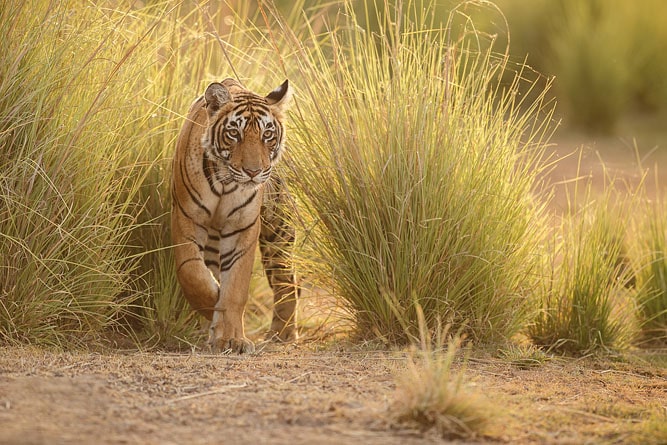Ranthambore National Park & Fort
Park and fort, 146 km from Bundi
could-see attraction
Opening hours: 6:00am-6:00pm
Address: Ranthambhore Road, Vigyan Nagar, Sawai Madhopur, Rajasthan
Visit duration: People typically spend up to 3 hours here
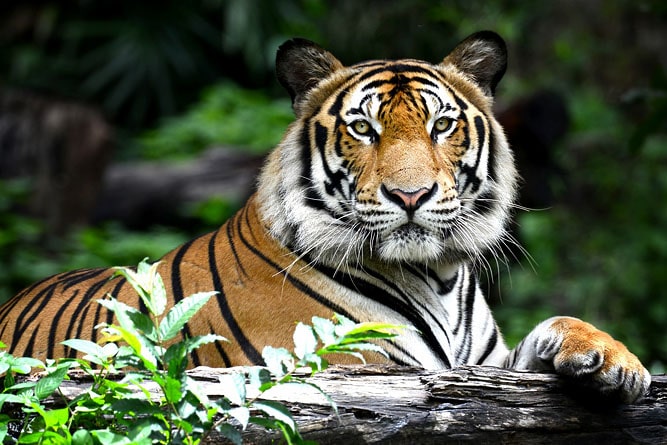
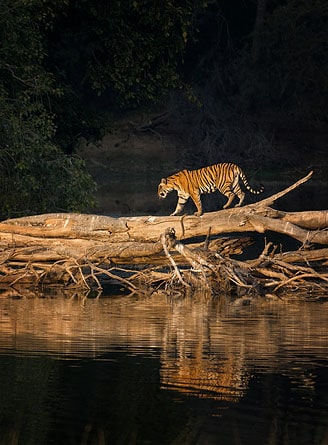
About Ranthambore National Park & Fort
Ranthambore National Park is a sanctuary in Rajasthan, with a fort with the same name, settled at its core. The Chambal river flows to its south and the Banas river to its north. The sanctuary is an abode for the wild tigers of Rajasthan. The forest also consists of ancient temples and mosques, cenotaphs, hunting pavilions and a crocodile-filled lake.
Dating back to the Chahamanas dynasty, the fort is almost a millennium old. From the Ranthambore Fort, you get a panoramic view of the sanctuary which marks its edges by rocky ridges. The Jaipur royals used the forest as the hunting ground till the very end of the 20th century. The forest derives its name from housing the fort.
In 2013, UNESCO proclaimed the Ranthambore Fort a World Heritage Site.
History of Ranthambore Fort
Ranastambhapura, meaning the city of the battle post, was the earlier name of the fort. The Ranthambhore Fort was constructed around the 10th century during the Chauhan Rajputs' reign. However, the dispute on whether King Jayant or King Sapaldaksha initiated the construction still continues.
Foreign invader, Muhammad of Ghori seized the fort after defeating the Chauhan ruler, Prithviraj. However, the Chauhans reclaimed the fort after the death of Sultanate ruler Iltutmish.
The fort continued to be snatched once by the Delhi Sultanate and then again by Rajput Chauhans in the following decades. The royals of Mewar's arrived in the 14th century and annexed the fort from Delhi Sultanates. the Sisodia clan occupied the fort. The fort temporarily passed to Hada Rajputs of Bundi and then to Sultan Bahadur Shah of Gujarat until the arrival of Mughal Emperor Akbar.
In the 17th century, the Kachwaha dynasty, a Rajput clan, occupied the fort and it remained a part of Jaipur until Indian Independence.
The Ranthambore National Park was a hunting ground till 1970. The park was finally announced as a sanctuary and initiated the Tiger Reserve in 1973. The forest officially became a national sanctuary on 1 November 1980. Following years, the neighbouring forests were declared the Sawai Man Singh Sanctuary and Keladevi Sanctuary. The Tiger Reserve expanded and included more forests within the project.
Architecture of Ranthambore Fort
The hills of the forest are linked by a rocky bridge which has an arched doorway. This leads you to the Ranthambore Fort. The path beyond the doorway continues ahead and is enclosed by hills on either side. Finally, you reach the centre of the forest where you ascend more than a hundred steps to enter the fort.
At the end of the flight, the entrance is at the right. A giant wall stands in front of the entrance in an odd layout that serves to protect the fort from any intrusions by elephants. It is a tall, arch-shaped gate with spikes attached to the doors. The fort is spread across 102 hectares of area and settled at a height of 700 feet.
Beyond the door lies the edifices in ruins. Most of the buildings like the Badal Mahal and Dulal Mahal are in ruins and look similar to an arcade column structure. The first gate is a Haathi Pool that was made in the shape of elephants but with time it got disfigured. The Ganesh pool gateway is still in shape.
The entire fort is made of rocks and patterns are carved on rocks. The various hues of red and brown now faded highlight the long life of the fort and how it shinned in its youth shinned with glory.
At the pinnacle of the hill lies a Battees Khamba that features authentic and ethnic Rajput architecture comprising Rajasthani-designed canopies, chattris topping the minarets, a pillared hall and a giant dome.
A temple in the fort still retains its layout and is engraved with floral carvings on arched columns and faded paintings by artists of the bygone eras. The fort houses red Karauli stone temples, a Ganesh temple, a Jain temple and a Shiva temple along with many other edifices. The wide and serene view of the lake is amusing from the fort.
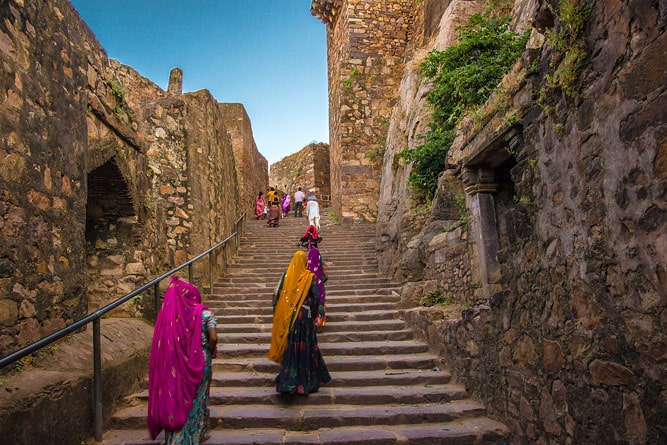
Wildlife Safari in Ranthambore Tiger Reserve
Ranthambore National Park features dry deciduous forests with grassy meadows and rocky terrain on the Aravali Range. The forest occupies 392 square kilometres with the Tiger Reserve covering almost 334 square kilometres of area and elevates from 700 feet to almost 1700 feet.
Ranthambore National Park hosts wildlife that includes the southern plains grey langur, Bengal tiger and fox, and native wildlife like elephants, leopard, wolf, hog deer, mongoose, squirrel, hare, porcupine and muntjac. Asian palm civets, Sloth bear, Black buck, Greater false vampire bat, rhesus macaque and mugger crocodile also take shelter in the sanctuary. The forest is home to a diversity of trees, plants, reptiles and birds.
Ranthambore is known for its tigers. However, the tiger population is in decline due to poaching and other illegal reasons. The outcome was that only 26 tigers were living in the park in 2005. Fortunately, with the help of the tiger reserve project, the number has increased to 62 according to the census of 2014.
In 2016, Machli Sr, a 20-year-old tigress held the title of the oldest living tigress in the world. She also holds the honour of being the most photographed tigress in the world. Following her, T19, the present queen of Ranthambore is her daughter who becomes known as the longest living tigress in a wild environment to date.
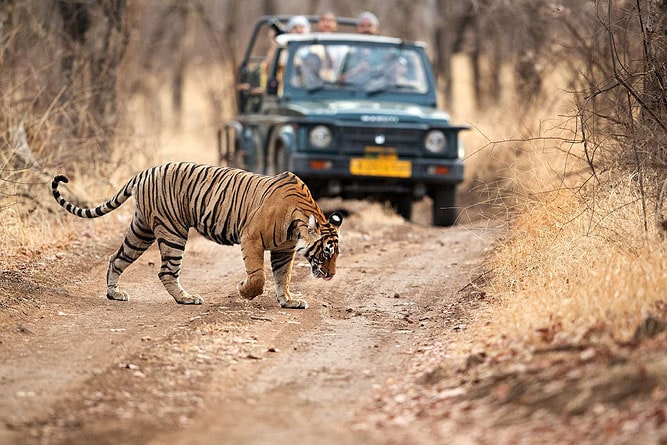
Entry fee and timings
The Ranthambore Fort and national park are open every day from 6:00 am to 6:00 pm. The cost of a safari ranges around ₹1000 or more.
Facts and tips about Ranthambore National Park & Fort
- In the 12th century, during the reign of Prithviraj I, the fort was influenced by Jainism whereas the temple of Mallinatha was built during the Mughal era.
- The sanctuary harbours a banyan tree which is located near the lake and is considered the second largest plant in India. The flora includes 539 species of flowering plants in the park.
- According to the visitors to the fort, leopards or tigers appear in the fort or sometimes seek shelter in the edifices since the fort is surrounded by forest. So always be aware of your surroundings and stay near the crowd. The fort demands a lot of climbing which means comfortable footwear and hats and umbrellas to beat the heat of the sun.
How to reach Ranthambore National Park & Fort
Ranthambore National Park is located in eastern Rajasthan. It can be reached in 3 hours by car from Bundi, in 3.5 hours from Jaipur and in 5.5 hours from Agra.
See location on Google Maps
Other attractions near Ranthambore National Park & Fort
- Bundi - 146 km
- Jaipur - 192 km
- Agra - 258 km
FAQs about Ranthambore National Park & Fort
1. Can I see a tiger while visiting the Ranthambore fort or the forest?
No, having the chance to witness a tiger needs a lot of luck as be it in the fort or while enjoying a safari, despite being a reserve sighting a tiger is a rare event.
2. Why do we have to leave the fort with the fall of dusk?
As the night approaches, the wild animals start roaming freely on the premises. Since these carnivorous animals walk in stealth mode, it is safer to tour the fort during daylight hours.
3. What is the best time to visit the fort and the sanctuary?
There is no good time as the site demands a lot of trekking and walking which is always exhausting under the heat of the sun, especially for travellers who don’t exercise regularly. So, the site is worthy enough to make you shed some calories.
